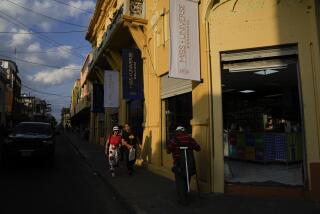Chinese immigrants give back to U.S.
Pasadena resident Ming Hsieh made a fortune from fingerprint identification software that helps U.S. authorities catch welfare cheats, guard the border and assist police in cracking cases.
Cyrus Tang built a Las Vegas-based business empire of specialty steel, pharmaceuticals and furniture. And in the heart of Silicon Valley, Jerry Yang developed one of the largest Internet search engines in the world -- Yahoo.
All three wildly successful entrepreneurs are Chinese immigrants, and now they and others like them are giving back to their adopted homeland in a new gold rush of philanthropy that is bringing hundreds of millions of dollars to U.S. universities, think tanks and other nonprofit groups.
“America is built by immigrants, and they all followed the same route,” said Hsieh, 52, a survivor of China’s Cultural Revolution and near-billionaire who gave $35 million to his alma mater, USC, in 2006. “You come here with a dream, and once you reach your dream, the issue is how to help the next generation fulfill their dream.”
Although waves of Chinese migrants came to California 150 years ago as poor laborers lured by reports of gold mountains, many of today’s immigrants come for higher education or skilled jobs. Some of them struck gold after launching businesses in engineering, software, finance and other fields and have begun to share their wealth.
The rising force of ethnic Chinese philanthropy is most apparent in major gifts, such as the $75 million to Stanford University last year by Yahoo’s Yang and his wife, Akiko Yamazaki. But such large gifts are still relatively rare; the Chronicle of Philanthropy’s annual list of biggest American donors -- generally the top 60 or so who contributed at least $10 million -- has included ethnic Chinese contributors just four times since 2000.
Instead, they are making more noticeable marks though gifts of $1 million or less. They are funding academic programs, such as retired banker Wilbur Woo’s Greater China annual economic conference and plastics entrepreneurs Shirley and Walter Wang’s new program on Chinese Americans and U.S.-China relations, both housed at UCLA. They are supporting medical institutions, such as air freight firm owner Ernie So’s annual monetary gifts at the City of Hope medical center.
They are promoting cultural projects, such as the hundreds of ethnic Chinese who have pitched in to help create one of the nation’s largest Chinese gardens at the Huntington Library, Art Collections and Botanical Gardens in San Marino.
And some, like Donald Tang, do a little of everything. Tang, a Shanghai native who arrived in Los Angeles in 1982 with no English language skills and $20 in his pocket and is a longtime investment banking executive, spreads his annual seven-figure donations among United Way, Harvard Westlake School, the Asia Society, the Los Angeles County Museum of Art, Rand Corp. and Caltech, among others.
Many donors are being brought into mainstream nonprofit leadership positions. So, for instance, is the City of Hope’s first Asian American board member; the once staid and Eurocentric Huntington has invited five Chinese Americans to join its 60-member board of overseers, beginning in 2002.
“There is a palpable sense that Chinese Americans have, by any measure, become wildly successful and they are proud of it and want to give back,” said Suzy Moser, the Huntington’s assistant vice president of advancement, who tapped the ethnic Chinese community for most of the $18.3 million needed for the garden’s first phase.
Although there are no national statistics on the magnitude of ethnic Chinese philanthropy, fundraisers agree it appears to be on the rise.
A City University of New York study last year, for instance, found that Chinese family foundations in the area grew from 11 with assets of $23 million in 1990 to at least 47 with assets of more than $218 million in 2007.
In a 2004 study for Georgetown University, researcher Andrew Ho found that “the philanthropic potential has never been greater” among Asian Americans because of rising education and wealth. The Asian American share of affluent U.S. households -- those with more than $500,000 in investable assets -- grew from 1% in 2002 to 5% in 2004, with an average net worth of $2.9 million, Ho found. Nearly half of all Asian Americans have a college degree or more education, compared to 27% of Americans overall.
Ho and others say the new flurry of philanthropy challenges negative stereotypes of Chinese as frugal and even stingy people who are slow to support mainstream charitable causes. Those stereotypes, in fact, are one reason community groups are actively promoting philanthropy.
A 2001 survey found that one in five Americans polled said Chinese Americans “don’t care what happens to anyone but their own kind” and were not likely to participate in their community.
The survey prompted the group that commissioned it -- a national organization of Chinese American leaders called the Committee of 100 -- to encourage philanthropy by honoring major donors and publicizing charitable works. The committee has honored Tang, Hsieh and others, and its members and supporters have raised at least $3.5 million for relief efforts since last month’s earthquake.
“There’s an unprecedented wave of philanthropy by Chinese Americans that is breaking records in the level and breadth of giving,” said Stewart Kwoh, the committee’s Southern California regional vice chairman. “It’s important to make the broader public aware of how this philanthropy is strengthening communities, which will help reduce misunderstandings and stereotypes.”
Community leaders say that philanthropy has a long tradition in China -- philosopher Confucius extolled it as a sign of “nobleness and superiority of character” -- but is expressed differently than in the West. Although Americans may be accustomed to sending money to institutions to help solve social problems, the Chinese have typically focused their benevolence more personally on families, villages and clans, according to Ho, a manager for family foundations.
Moser of the Huntington, who mastered the cultural fine points of Chinese giving as a development consultant in Hong Kong for several years, said approaching people through personal relationships known as guanxi is critical. So when she needed to raise money for the Chinese garden, she knew better than to simply send out impersonal mailers. She enlisted influential Chinese American business leaders, including Dominic Ng, chief executive officer of the East West Bancorp Inc., to help out.
Ng, a Pasadena resident and Hong Kong native, put together a dinner with several of his high-powered Chinese American friends, including David Lee, former president of Global Crossing, , Andrew Cherng of the Panda Express restaurant chain, Beverly Hills real-estate magnate Roger Wang and others. A group of Chinese American women began holding monthly lunches for their friends. Eventually, many of them began pledging gifts.
“When I first pulled the team together, my reason was very simple: to make sure we Asian Americans step up and deliver something very important to the community at large,” Ng said.
The urbane banker, who has donated millions to such causes as the Huntington and United Way and has recently acquired a collection of Chinese art for donation to the Museum of Contemporary Art, has long advocated more Asian American philanthropic work. In 1999, he became the first Asian American to head the United Way of Greater Los Angeles’ fundraising campaign and broke records by raising $67 million in nine months. He then helped convince Cherng and Tang to chair the effort in succeeding years.
Some immigrants still focus much of their giving on China. Last year, China received $25.7 billion in remittances, mostly from the United States -- the second highest recipient country after India, according to the World Bank. But many of their American-born children are shifting priorities.
The Tam family of San Marino, for instance, reflects those generational differences. Robert Tam, a 47-year-old investor, said his Hong Kong-born father has built roads, schools, medical clinics, water sanitation plants and the like for his family’s ancestral village in southern China. But Tam prefers to give locally with gifts to the Huntington, San Marino schools and others..
Even immigrants, however, begin to acquire U.S.-style philanthropic practices with time, according to an Indiana University study last year. Zhihang Chi, the Los Angeles-based general manager for Air China’s Western operations, is a case in point. He arrived in the United States in 1988 to pursue a doctoral degree at the Massachusetts Institute of Technology. Philanthropy, he said, was a “very foreign idea.”
“When we first come here, our first priority is survival: get a degree, find a job, gain success in a career,” Chi said.
But the longer he lived here, the more accustomed he said he became to donation requests from his children’s schools, public TV and radio, alumni associations. He began to give and now has convinced his Beijing-based airline to do the same.
In its first major contribution to a mainstream organization, Air China made a $170,000 in-kind donation to the Huntington’s garden project last year by flying 58 artisans from China to work here.
It was a “leap of faith,” Chi said, propelled both by business desires to cultivate U.S. customers and the philanthropic impulses he said America nurtured in him.
“Now I’ve been here 20 years and my ideals have gradually been changing,” Chi said. “There’s more to life than money, and we all need to do good.”
--
More to Read
Start your day right
Sign up for Essential California for news, features and recommendations from the L.A. Times and beyond in your inbox six days a week.
You may occasionally receive promotional content from the Los Angeles Times.







